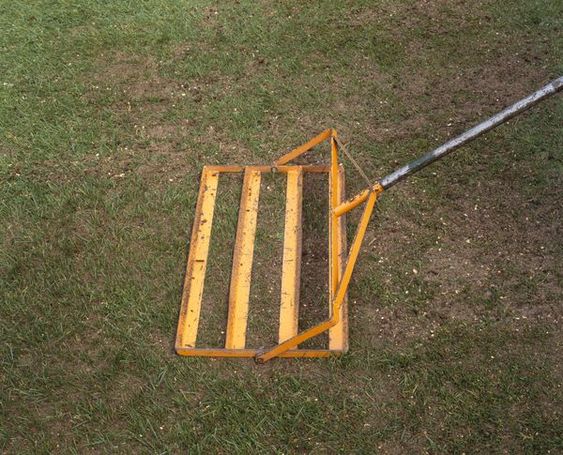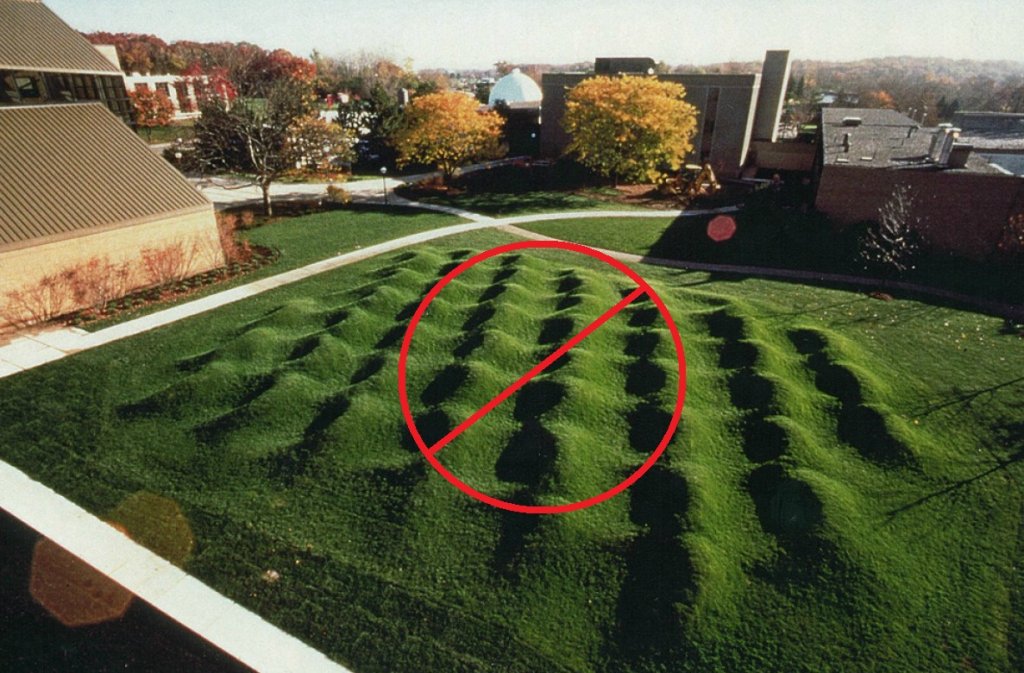A beautiful and well-maintained lawn is something every garden lover would prefer. But have you ever noticed bumps in your lawn? Well, if your lawn is old, you have probably noticed them. Whether big or small if your garden has developed any kind of bumps, it is a matter of concern. So, if you have not yet, you should start thinking about how to level a lawn evenly.
Why Do Lawns Develop Bumps?
Before getting started on how to level a lawn, you should think about the reason. Finding the core reason would help you solve the problem more quickly and easily. A common reason for developing bumps is leakage in any of the pipelines. Broken water or irrigation pipes cause erosion and depressions in the lawn may be the result of drainage problems.

So, if your lawn shows bumps or depressions at places where there may be pipelines or drainage problems, you should get it checked. You can check it yourself or hire professionals for the purpose. Sometimes, insect problems and diseases also cause a lawn to develop bumps or depressions. It is recommended to have a check on that too.
Other common reasons for an uneven lawn can be any buried objects that should be removed, heavy foot traffic on very soft parts of the lawn, or animals.
Is It Important to Level Your Lawn?
Anyone would want to know about how to level a lawn only when he knows that it is important. Well, yes, it is important to maintain your lawn’s level. However, the main question is why? If there are just a few bumps or sinks here and there, what difference does it make? So, to let you know, it makes a lot of difference.
Even if you do not use your lawn much, it makes a major difference to the health of your lawn. If your lawn has even minor holes, it will collect rainwater and will cause lawn diseases. Moreover, the little sinkings will make your mower cut more grass at the higher levels of the lawn. On the other hand, the bumps of your lawn will make the mower scalp the lawn because your mower would be jumping after every bump.
In short, leveling your lawn will give it a healthier and longer life. Also, it will help you maintain the lawn easily. An even and smooth lawn also allows you to use it better and
makes every activity safer and more amusing. With a plane green surface, your lawn will always be ready for children to come over or adults to enjoy.
Now that you know why it is important to level a lawn, let us see how to level a lawn and with what equipment.
Equipment You Can Use for Lawn Levelling
On searching for how to level a lawn, you will find numerous techniques and tools. The basic tools you will need are- plastic leaf rake, hand rake, shovel, edger, a large push broom, wheelbarrow, and a leveling rake.
All other pieces of equipment are common, and you can use any brand or pattern you have. However, the leveling rake that you are going to use is what matters the most.
Here, we have two of the best leveling rakes, also known as a level lawn that you can use for the process.
1. Standard Golf Levelawn
- ACHIEVE WIDER COVERAGE AND FASTER LEVELING - The 30” wide head of our leveler allows you to cover...
- EFFORTLY DISTRIBUTE FOR SUPERIOR RESULTS - Thanks to its well-crafted construction, the Levelawn...
- TRUSTED BY GOLF COURSE SUPERINTENDENTS WORLDWIDE - The Levelawn Tool's popularity among golf course...
- TWO PIECE WOOD HANDLE - The Levelawn Tool from Standard Golf Company is equipped with a high-quality...
2. Rocklin Industry Levelawn Tool
- 🌱 Levels soil and dirt evenly. Get rid of unwanted dips and divots by filling them with dirt and...
- 🌱 Ground plate measures 30” x 10”. The perfect size for easy mobility, functionality, and...
- 🌱 78” Extra long handle lets you cover more ground with less effort. Removable handle section...
- 🌱 Will work on any type of grass including Bermuda, Kentucky Bluegrass, Ryegrass, St. Augustine,...
These two rakes can majorly help you with leveling your lawn to a great extent. Both the tools will help you remove stones and break up clumps to get an even surface eventually. For the final leveling, push brooms and other rakes are usually preferred but leveling rakes give you much better results. Once you have a level lawn, it is time for you to analyze the problem your lawn has.
How Much Levelling Does Your Lawn Need?
The very first step to execute before you read how to level a lawn is checking for the extent of the problem you have. Different methods are used to cure different levels of bumps and depressions in a lawn. So go ahead and check if your lawn has severe bumps or does it have just a few bumps and depressions that can be filled easily. Only after knowing the severity of the problem, you will be able to choose the solution.
For Mildly Uneven Lawns
If your lawn shows mild bumps (around an inch), you can simply flatten them by stepping on them after making them soft. Another solution is using a water roller on the place. You can use a water roller until the bump levels up. However, keep in mind to not overuse the roller as it will make the soil compact and lead to more problems.
Consider Top-dressing: Top-dressing is also an option you can opt for mild irregularities. The steps are very simple and easy, keep reading to know.
- Mow the lawn to the lowest you can and use a garden rake to detach the lawn. 2. Mix a batch of leveling mix in a wheelbarrow and apply scoops of soil mix to the low areas of the lawn. You can do this with a shovel.
- Spread the top dressing evenly with a rake and apply around ½” of soil mix to lower areas of the lawn. Make sure you do not use more of it as it will destroy the grass.
- Now, use a push broom or a level lawn to mix the soil mixture with the grass evenly. Do this till you see mainly grass on the ground.
- The last step is to water the lawn to stabilize the grass. This process can be repeated if you do not get the expected results. Just make sure that you give the grass time to recover before repeating the process.

For Moderately Uneven Lawns
If your holes are a little bit deeper, then top-dressing will not work efficiently. Instead, you would have to remove the sod, fine, and solve the sinking and then fill it back with new soil or the same sod. While removing the sod, you need to gently remove them so that the roots separate from the soil. If it has been cut into strips, it is recommended to roll them to retain the moisture and keep them in shade.
Once you remove the sod, fill enough topsoil in the hole that it gets even after putting back the sod. Also, keeping adding water in the hole with soil to avoid any air and to settle the soil well. Lastly, if the sod is in good condition, it can be planted back. If not, then you can plant a new sod or seeds. Water the place thoroughly after completing the process.
For A Severely Uneven Lawn
Top-dressing and sodding are techniques that can be used for a few depressions and bumps. When you are looking for how to level a severely uneven lawn, you need to put in more effort. You would have to regrade the area and eventually set up a whole new one.
lawn. So, if you think your lawn needs the process of Re-grading, keep reading to know everything about it.
How to Re-grade a Lawn
The main purpose of re-grading the land is usually to get a sloppy lawn in level. If your lawn has this problem, then this is the answer to your “how to level a lawn that is sloppy”. The important thing to consider while thinking about re-grading your lawn is that the slope should always be against your house.
The slope should be dropped around 2 or 3 inches every 10 feet. If this drop is greater than a foot, you should prefer covering it with artificial grass or get a retaining wall built. When you decide to build a retaining wall, make sure it is strong, durable, and functional for years to come. Purchase high quality retaining wall sleepers from a trusted supplier like Retaining Wall Supplies.
Here are the steps that you should be taking to re-grade your lawn.
- Firstly, you need to establish a slope line for your yard to drain properly. For this, you can get a transit level tool rented from any local shop. The second option is to place stakes in the ground. However, the transit level tools work better but the choice is yours.
- After making your slope line, you need to work on the problematic areas by removing the topsoil from them. Fill in the deeper areas and scrap out subsoil from higher areas. If your lawn size is bigger, you may need larger equipment for this process. You can either do it yourself or if it seems too much hard work, you can always hire someone.
- Spread some topsoil on the first two inches of the subsoil. The chances of drainage problems will reduce by doing this.
- After mixing the topsoil with subsoil, you can add the rest of the topsoil evenly on the ground (around up to 4 inches).
- After completing all the above-mentioned processes, you can either sod the lawn or add seeds to get fresh grass. The newly established lawn should match with the level of other elements in your lawn like the walkway, patio, etc.).
How to Make Your Levelled Lawn Last Longer?
The process of leveling a lawn is not a one-time process. With passing time and changes in the environment, the problem would occur again. However, you can avoid the development of new bumps for a considerable time by taking a few steps. Regular care and maintenance of the lawn are necessary to avoid the problem from developing again.
Apart from regular care, there are two main things that you can do to avoid further bumps.
- When the soil is very wet, try to avoid foot traffic in the lawn as much as possible.
- Change your cutting patterns regularly to avoid ruts from your lawnmower wheels. When you mow the lawn in the same pattern, it creates ruts and eventually gives the space for bumps to occur.
When to Get Started?
If you are planning on leveling your lawn, it is also important to consider the time of your leveling. One thing to keep in mind when you are planning on the process is to never execute it in winter. Winters are the worst time to start leveling your lawn because the soil goes dormant in the season.
Springs are the best time to level your lawn for basic repairs. The spring season gives time for grass to grow in and provides moisture to the soil to settle efficiently. However, if there are major repairs, the process can become worse in the spring. As the ground becomes quite soft due to the melting of the snow, it can result in new bumps if there is too much traffic.
When Are You Levelling Your Lawn?
After reading everything about how to level a lawn, you probably know that it is important to level your lawn if you have not yet. Moreover, if you have not checked on your lawn for bumps, then take this as a signal and start checking your lawn. Depending on the bumps your lawn has and the condition, decide the right time and process for yourself. Leveling your lawn will make it grow efficiently!



